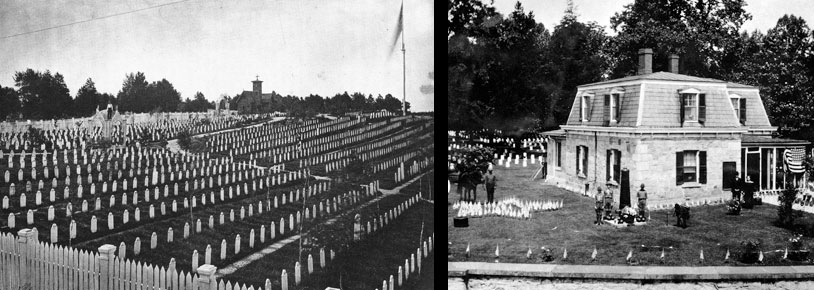

Civil War Era National Cemeteries: Honoring Those Who Served
Chattanooga National Cemetery
Chattanooga, Tennessee
 |
| Andrews’ Raiders Monument and the graves of the Medal of Honor recipients who participated in the raid Courtesy of the Department of Veterans Affairs, National Cemetery Administration, History Program |
During the Civil War, Chattanooga became an important target for both the Union and the Confederacy. With transportation links along the Tennessee River and several railroad lines, the city offered a “Gateway to the Deep South.” In September 1863, the Confederate’s Army of Tennessee led by General Braxton Bragg defeated Major General William Rosecrans’ Army of the Cumberland at Chickamauga, Georgia. Lieutenant General James Longstreet forced his way through an opening in the Union line, driving back Union troops. Union Major General George H. Thomas and his men held their position on Snodgrass Hill, earning Thomas the nickname the “Rock of Chickamauga,” allowing the remaining troops to retreat safely toward Chattanooga. Though the Union was defeated, casualties were roughly equal for the two sides, with approximately 18,000 for the South, and 16,000 for the North.
Two months later, the armies again met at Chattanooga. Between November 23 and 25, a series of battles took place at Orchard Knob, Lookout Mountain, and Missionary Ridge. At Missionary Ridge, the Confederate artillery held the high ground with infantry support below, but Union General Thomas drove his men forward, pushing Confederate troops back up the steep incline toward their own artillery. The Confederate line broke, and the routed Southern army made a hasty retreat into Georgia. A recently promoted Second Lieutenant, Arthur MacArthur, father of World War II hero Douglas MacArthur, received the Medal of Honor for his actions that day.
 |
The 4th Army Corps Monument |
U.S. Army Chaplain Thomas B. Van Horne, who laid out the cemetery, took inspiration from the natural topography and rock outcroppings of the site saying, “Where nature suggested avenues they have been made and their curves define the sections.” As a result, the burial sections are a variety of irregular shapes, including circles, shields, and triangles. Each section contained a central mound available for a monument, with the graves of officers and enlisted men circling the monuments in concentric rings.
The main entrance to the cemetery, located on the site’s eastern boundary off South Holtzclaw Avenue, features two gates. Other entrances are located on Bailey Avenue, on the cemetery’s north side, and at the southwest corner of the site, off Central Avenue. A three-foot tall stone wall topped with a short wrought-iron fence marks the northern boundary of the cemetery, wrought-iron fencing is used along the eastern boundary, and chain link fencing is used elsewhere. Sitting atop the central hill is the cemetery’s flagpole, flanked by four seacoast artillery cannons set upright on concrete bases. The Circle of Honor around the hill features several modest granite monuments dedicated by veterans' organizations and specific military divisions. Located near the pond at the western corner of the cemetery is a monumental granite arch erected in 1880. One of only five in the national cemetery system, the arch stands over 35 feet tall.
Several unique monuments are located at the Chattanooga National Cemetery. The Andrews’ Raiders Monument, dedicated by the State of Ohio in 1890, honors Union spy James J. Andrews of Ohio, and 24 of his men who snuck deep into Confederate territory on a mission to cut rail and communication lines. On April 12, 1862, the men boarded “The General,” a wood-burning locomotive, at Marietta, Georgia, while the passengers and conductor enjoyed breakfast. The raiders took off in the engine, heading north, cutting telegraph lines and tearing up the rail tracks along their way. The train’s conductor and others gave chase, commandeering two other trains as they encountered broken tracks. When the raiders reached Ringgold, Georgia, 80 miles northwest of Marietta, they jumped from the train, scattering in the forest. Andrews was captured and eventually hanged in Atlanta. He and eight others from the mission are buried in Section H of the Chattanooga National Cemetery. Four of Andrews' Raiders buried here received the Medal of Honor, although Andrews, as a civilian, was ineligible. The monument to these daring raiders is also located in Section H of the cemetery and consists of a granite pedestal topped with a bronze replica of "The General."
 |
Monumental Arch Courtesy of the Department of Veterans Affairs, National Cemetery Administration, History Program |
Prominent burials at Chattanooga include General William P. Sanders, the only southern-born Union officer to be killed during the Civil War and the cousin of Jefferson Davis, buried in Section C, Grave 1601. S. Miller, a veteran of the Revolutionary War, is buried in Section B, Grave 830.
Chattanooga National Cemetery is the final resting place for seven recipients of the Medal of Honor, the nation’s highest military decoration, given for “conspicuous gallantry and intrepidity at the risk of his life above and beyond the call of duty.”
| Plan your visit |
Chattanooga National Cemetery is located at 1200 Bailey Ave., in Chattanooga, TN. The cemetery is open for visitation daily from dawn to dusk; the administrative office is open Monday to Friday from 8:00am to 4:30pm, and is closed on all Federal holidays except for Memorial Day and Veterans Day. For more information, please contact the cemetery office at 423-855-6590, or see the Department of Veterans Affairs website. While visiting, please be mindful that our national cemeteries are hallowed ground. Be respectful to all of our nation’s fallen soldiers and their families. Additional cemetery policies may be posted on site. The Chickamauga and Chattanooga National Military Park, a unit of the National Park System, preserves the battlefields of the Chattanooga Campaign. Chattanooga National Cemetery lies within the Tennessee Civil War National Heritage Area. Chattanooga National Cemetery was photographed to the standards established by the National Park Service’s Historic American Landscapes Survey. |